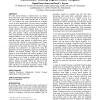Free Online Productivity Tools
i2Speak
i2Symbol
i2OCR
iTex2Img
iWeb2Print
iWeb2Shot
i2Type
iPdf2Split
iPdf2Merge
i2Bopomofo
i2Arabic
i2Style
i2Image
i2PDF
iLatex2Rtf
Sci2ools
CHI
2005
ACM
2005
ACM
MusicCube: making digital music tangible
To some extent listening to digital music via storage devices has led to a loss of part of the physical experience associated with earlier media formats such as CDs and LPs. For example, one could consider the role of album covers in music appreciation. Previous efforts at making music interaction more tangible have focused mainly on access issues. A case study is presented in which several content attributes of Mp3 formatted music as well as control access are made more visible and tangible. Play lists, music rhythm, volume, and navigational feedback were communicated via multicolored light displayed in a tangible interface. Users were able to physically interact with music collections via the MusicCube, a wireless cube-like object, using gestures to shuffle music and a rotary dial with a button for song navigation and volume control. Speech and non-speech feedback were given to communicate current mode and song title. The working prototype was compared to an Apple iPod, along the di...
CHI 2005 | Digital Music Collections | Ergonomic Qualities | Human Computer Interaction | Keywords Tangible Interaction |
| Added | 30 Nov 2009 |
| Updated | 30 Nov 2009 |
| Type | Conference |
| Year | 2005 |
| Where | CHI |
| Authors | Miguel Bruns Alonso, David V. Keyson |
Comments (0)

